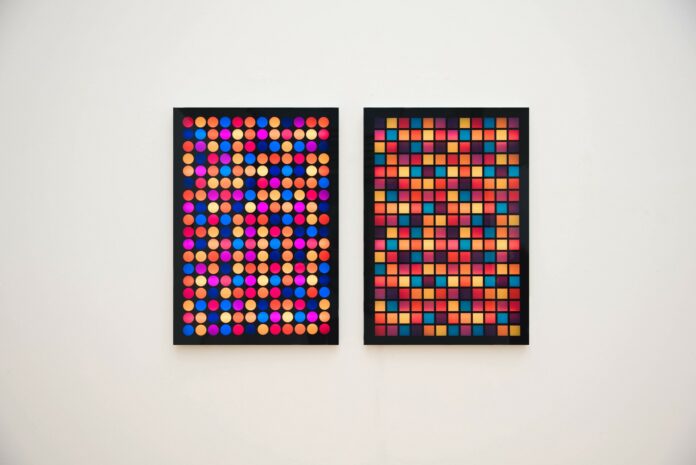24! Questions for the Concrete Present
www.kulturspeicher.de
www.mkk-ingolstadt.de
Facebook / Instagram / Facebook / Instagram
Museum für Konkrete Kunst, Ingolstadt
Museum im Kulturspeicher, Würzburg
On Friday, March 22, and Saturday, March 23, 2024, the Museum für Konkrete Kunst (MKK) in Ingolstadt and the Museum im Kulturspeicher (MiK) in Würzburg are opening the exhibition 24! Questions for the Concrete Present. This extensive cooperative show takes the hundredth birthday of the term Concrete Art as an occasion to test the topicality of this art movement. The two parts of the exhibition in Ingolstadt and Würzburg will present twenty-four young artists from Germany and abroad. The central question is how today’s young generation is adapting for itself the concept and ideas of the “Concrete”: Is Concrete Art still topical?
Concrete Art—according to tradition, the Dutch artist, architect, and theorist Theo van Doesburg (1883–1931) first coined the term and used it for his own works in 1924. Although this art movement dedicated itself to precision and clarity, the history of the origin of the name cannot be verified with certainty. One hundred years later, this unofficial anniversary nevertheless offers a suitable opportunity to ask today’s generation of young artists who are close in style to the movement about the details of their relationship to Concrete Art. What influence does its beginnings have on their own creative work? Are the term Concrete Art and the associated principles still relevant today?
MiK and MKK have invited twenty-four artists from Germany and abroad who were born from 1980 onward to provide detailed information about their relationship to Concrete Art. Around the same age as van Doesburg and other important pioneers of the movement in 1924, they seem especially well suited to report on the current status of the art movement and to look toward its future. The works shown demonstrate that principles more than a century old have remained topical and adaptable.
The works by the twelve artists represented at the MKK belong to very different genres, including, for example, intricate, filigreed drawings by Lena Ditlmann and Marile Holzner, strictly geometrically conceived paintings of Carsten Beck, sculptural works by Martim Brion, and a large installation by Anna-Maria Bogner that fills a room. The exhibits selected for the show also illustrate the broad palette of forms of artistic expression and techniques that are essential to Concrete Art. Silvia Inselvini’s monochrome drawing thus join a dialogue with paintings and paper cutouts by Vladiana Ghiulvessi, Toulu Hassani, Jonas Weichsel, and Fiene Scharp, which in various forms grapple with the grid and other ordering structures. In a large wall work produced especially for the exhibition, Dave Grossmann engages with the design principles of Concrete Art. Marco Stanke’s objects that oscillate between painting and sculpture profoundly challenge our expectations of an image.
The twelve artists presented at the MiK are also diverse: The spectrum ranges from Erika Hock’s sculptural string objects, which invite sensory exploration and lingering, to Sali Muller’s mirror works, which focus on the subjectivity of perception. The works by Sebastian Dannenberg and Schirin Kretschmann address the museum space and engage with the limits and tipping points of painting. Charlotte Giacobbi, Cătălin Pîslaru, Virginia Toma, and Patrizia Kränzlein also work with painting and drawing, but in two dimensions, employing its means, processes, and ordering structures. Amalia Valdés Mujica combines Latin American symbolism and geometry in her reliefs. The boundaries between genres and methods are transgressed by the sculptures and photographs of Nina Brauhauser. Fabian Gatermann takes a variety of approaches to explore the phenomenon of light, such as algorithms and Plexiglas. The artistic duo Banz & Bowinkel employ computer-aided augmented reality (AR), juxtaposing the digital and the physical.
Whereas the MKK is dedicated exclusively to Concrete Art, this movement became a thematic focus for the MiK in Würzburg when it acquired the Peter C. Ruppert—Concrete Art in Europe after 1945 Collection. The cooperation of the two institutions has made it possible to present a broad selection of artists and to engage together with the present and future of Concrete Art. Another element linking the two shows is an exhibition catalogue being published by the Deutscher Kunstverlag. It has 176 pages and contains texts by Mariana Aravidou, Dr. Henrike Holsing, Dr. Mathias Listl, and Dr. Theres Rohde. The catalogue is available for 34 euros in both museum shops and in bookstores (ISBN: 978-3-422-80222-3).
100 years later of Concrete Art Movement
Although Concrete Art comes across as very precise, it is only possible to say approximately when the name was born. In his manifesto of the same name, Theo van Doesburg officially introduced the term to art theory in 1930. But the Dutch artist, architect and theorist is said to have conceived it for the first time and applied it to his own works as early as 1924.
100 years later, despite all the uncertainty, this anniversary is a fitting opportunity to question today’s generation of young artists with a stylistic affinity to the movement in detail about their relationship to Concrete Art. What influence have the beginnings of the art movement had on their own visual work? Are its principles still relevant today? And does the same apply to the name?
Museum für Konkrete Kunst (MKK)
Tränktorstraße 6–8
85049 Ingolstadt
Concrete art – according to tradition, the Dutch artist, architect and theorist Theo van Doesburg is said to have first formulated this term in 1924 and used it for his own works. 100 years later, despite all the uncertainty, this anniversary provides a suitable opportunity to ask the generation of young artists who are stylistically close to this direction in detail about their relationship to concrete art. What influence do the beginnings of the art movement have on their own creative work? Are their principles still relevant today? And the same applies to her name?
En el MKK participan los siguientes artistas: Carsten Beck – Anna-Maria Bogner – Martim Brion – Lena Ditlmann – Vladiana Ghiulvessi – Dave Grossmann – Toulu Hassani – Marile Holzner – Silvia Inselvini – Fiene Scharp – Marco Stanke – Jonas Weichsel
Museum im Kulturspeicher (MiK)
Oskar-Laredo-Platz 1
97080 Würzburg
ARTISTS SHOWN IN THE MUSEUM IN THE KULTURSPEICHER WÜRZBURG:
Banz & Bowinkel • Nina Brauhauser • Sebastian Dannenberg • Fabian Gatermann • Charlotte Giacobbi • Erika Hock • Patrizia Kränzlein • Schirin Kretschmann • Sali Muller • Cătălin Pîslaru • Virginia Toma • Amalia Valdés Mujica




